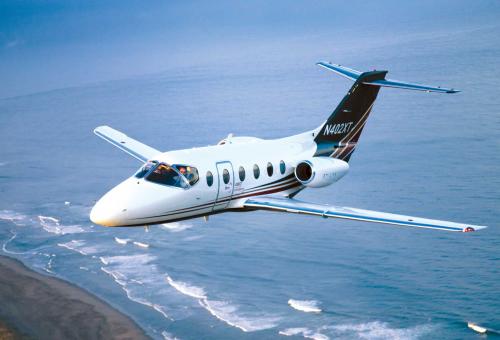
Nextant 400XT
The protagonist in the 1970s American television show The Six Million Dollar Man was an injured astronaut who’d had various
The protagonist in the 1970s American television show The Six Million Dollar Man was an injured astronaut who’d had various mangled body parts replaced with bionic ones that gave him superhuman abilities. All of this is recounted in the show’s opening credits, while the narrator enthusiastically intones, “We can make him better than he was before. Better, stronger, faster!”
This is basically what the folks at Nextant Aerospace have done with the venerable Beechjet 400A/Hawker 400XP, an airplane that Japan’s Mitsubishi designed in the 1970s called the Diamond. Beechcraft in the U.S. later bought the program from Mitsubishi and rebranded the airplane initially as the Beechjet and later as the Hawker 400XP.
Cleveland-based Nextant is giving the model new engines and avionics and a refreshed interior for a base price of $3.9 million, which includes the cost of acquiring a used aircraft for modernization. The upgrade increases range 50 percent, cuts climb times by one-third and chops operating costs 29 percent. It also makes the airplane marginally faster. The performance is comparable to that of new aircraft costing millions more and easily trumps that of in-class used models.
Even in their original form, Beechjets have been popular. The rugged and fast seven- to eight-passenger aircraft featured a “squared oval” fuselage that yielded more shoulder room than some of its competitors, a flat-floor cabin, an advanced airfoil and Pratt & Whitney Canada turbofan engines. It initially proved a worthy competitor to Cessnas and Learjets. Beechcraft improved the design in 1990 (the Beechjet 400A) and later as part of a rebranding effort that included a cabin block change (the Hawker 400XP). The XP has five windows on each side of the fuselage, which distinguishes it from the six-windows-a-side A.
Hawker Beechcraft suspended plans for another upgrade, badged the Hawker 450XP, in 2009 in part due to the faltering economy. The company announced last year that it was shuttering the production line after manufacturing nearly 600 civil aircraft, and 180 used as military trainers, over the last 20 years. And that likely would have been the end of the program if not for Kenn Ricci, founder and chairman of Flight Options, the second-largest fractional-jet share provider.
Nextant’s goal–unlike that of past re-engine and refurbishment programs–is serialized production. Therefore, rather than having customers bring their airplanes in for revamping, the company is buying used aircraft and converting and selling them.
Aside from the price point, several features of the 400A/XP make it an ideal candidate for conversion. Mitsubishi, as with its earlier MU-2 turboprop, substantially “overbuilt” the airframe to the point that it does not have a life limit. Most conversion candidates have accumulated 5,000 to 7,000 hours; fly 400 or fewer hours per year; and could easily survive to 30,000 hours of flight time or even longer. Nextant president Jim Miller thinks these airplanes could go another 30 years.
The 305-cubic-foot passenger cabin measures 4 feet, 9 inches tall and 4 feet, 11 inches wide and 15 feet, 6 inches long. Cabin pressure is equivalent to sea level up to 24,000 feet. External luggage capacity is a paltry 26.4 cubic feet but adding in-cabin closet space can increase storage room to 53.2 cubic feet. Overall luggage capacity is 800 pounds.
The 400XT gets a complete interior gut job as part of the basic upgrade–Nextant even replaces the soundproofing blankets. “The soundproofing that is in the airplane from the factory, particularly if it is an older airplane, is pretty ineffective,” Miller said, noting that some of it was lined with lead. Nextant retains and refurbishes the seat frames, but adds new foam and re-covers the seats in leather. The headliner, window lines, drink rails, sidewalls, carpeting and veneer are new. Customers can choose from four floor plans, all with single seats for five to seven passengers. However, Miller said Nextant is seriously looking at making a 60-inch-long, three-place divan available opposite the entry door to accommodate passengers with mobility issues and pets.
Interiors can be further enhanced with optional entertainment equipment and LED lighting. The Rockwell Collins Venue Cabin Management system costs $120,000. It includes a high-definition media center with file server; Blu-ray player; video wired to each seat; dual 1080p 10.6-inch monitors (more can be added at additional cost); four iPod/iPhone docking stations; 3D moving map; programmable switches at each seat, in the galley and in the lav; downwash, seat and table lighting controls; cabin temperature controls; and controls for optional electronically dimmable window shades. The shades provide a range of tints from 99.5-percent light blockage to fully clear. Passenger device power and connectivity comes from 110V AC and Ethernet receptacles mounted on either side of the cabin in the lower sidewalls near the aft edge of each fold-out table, and the Aircell Axxess Broadband system.
Nextant’s Miller said he expects average conversions to take 120 days. Nextant is slated to deliver about a dozen 400XTs this year, reaching an average annual production rate of 38 by 2014. Already, the program has received an order worth $150 million to convert forty 400A/XPs for Flight Options.
In October 2010, Hawker Beechcraft announced its own conversion program for the 400A/XP, called the 400XPR. Miller said Nextant did not view the XPR as competition because the specifics of the program are substantially different. The $2.24 million XPR package requires customers to bring their own aircraft to a Hawker Beechcraft service center. Like the Nextant program, this one adds Pro Line 21 avionics and Williams engines (in this case the FJ44-4A-32), and a refurbished interior. It also adds winglets.
With two re-engineering programs out there, it is clear Bionic Beechjets will be flying deep into this century–and for a lot less than the price of a Six Million Dollar Man.
Mark Huber welcomes comments and suggestions at: mhuber@bjtonline.com.

